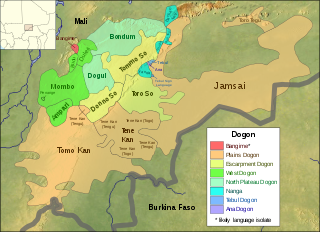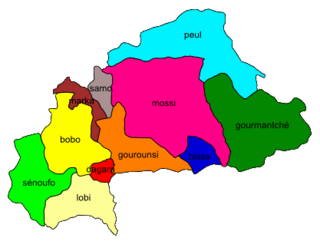In grammar, tense is a category that expresses time reference. Tenses are usually manifested by the use of specific forms of verbs, particularly in their conjugation patterns.
Dagbani, also known as Dagbanli or Dagbanle, is a Gur language spoken in Ghana and Northern Togo. Its native speakers are estimated around 1,170,000. Dagbani is the most widely spoken language in northern Ghana, specifically among the tribes that fall under the authority of the King of Dagbon, known as the Yaa-Naa. Dagbon is a traditional kingdom situated in northern Ghana, and the Yaa-Naa is the paramount chief or king who governs over the various tribes and communities within the Dagbon kingdom.
Rapa Nui or Rapanui, also known as Pascuan or Pascuense, is an Eastern Polynesian language of the Austronesian language family. It is spoken on Easter Island, also known as Rapa Nui.
Rapa is the language of Rapa Iti, in the Austral Islands of French Polynesia, and of Mangaia in the Cook Islands. It is an Eastern Polynesian language. There are three varieties of the Rapa language currently being spoken in French Polynesia: Old Rapa, Reo Rapa and New Rapa. Old Rapa has been mostly replaced by Reo Rapa, a mix of the more commonly spoken Tahitian and Old Rapa. New Rapa – revitalized Old Rapa – is commonly spoken by middle-aged and younger speakers. Rapa is a critically endangered language, and there are only around 300 speakers of Reo Rapa, with only 15% of them able to speak Old Rapa. It may be more vibrant on Mangaia, but there the population has been declining for half a century due to emigration.
Vaeakau-Taumako is a Polynesian language spoken in some of the Reef Islands as well as in the Taumako Islands in the Temotu province of Solomon Islands.
In linguistics and pedagogy, an interlinear gloss is a gloss placed between lines, such as between a line of original text and its translation into another language. When glossed, each line of the original text acquires one or more corresponding lines of transcription known as an interlinear text or interlinear glossed text (IGT)—interlinear for short. Such glosses help the reader follow the relationship between the source text and its translation, and the structure of the original language. In its simplest form, an interlinear gloss is simply a literal, word-for-word translation of the source text.
Máku, also spelled Mako, and in the language itself Jukude, is an unclassified language and likely language isolate once spoken on the Brazil–Venezuela border in Roraima along the upper Uraricoera and lower Auari rivers, west of Boa Vista, by the Jukudeitse. 300 years ago, the Jukude territory was between the Padamo and Cunucunuma rivers to the southwest.
In linguistic typology, object–subject–verb (OSV) or object–agent–verb (OAV) is a classification of languages, based on whether the structure predominates in pragmatically neutral expressions. An example of this would be "Oranges Sam ate."

Najdi Arabic is the group of Arabic varieties originating from the Najd region of Saudi Arabia. Outside of Saudi Arabia, it is also the main Arabic variety spoken in the Syrian Desert of Iraq, Jordan, and Syria as well as the westernmost part of Kuwait.
Ughele is an Oceanic language spoken by about 1200 people on Rendova Island, located in the Western Province of the Solomon Islands.

Bangime is a language isolate spoken by 3,500 ethnic Dogon in seven villages in southern Mali, who call themselves the bàŋɡá–ndɛ̀. Bangande is the name of the ethnicity of this community and their population grows at a rate of 2.5% per year. The Bangande consider themselves to be Dogon, but other Dogon people insist they are not. Bangime is an endangered language classified as 6a - Vigorous by Ethnologue. Long known to be highly divergent from the (other) Dogon languages, it was first proposed as a possible isolate by Blench (2005). Heath and Hantgan have hypothesized that the cliffs surrounding the Bangande valley provided isolation of the language as well as safety for Bangande people. Even though Bangime is not closely related to Dogon languages, the Bangande still consider their language to be Dogon. Hantgan and List report that Bangime speakers seem unaware that it is not mutually intelligible with any Dogon language.

Pichinglis, commonly referred to by its speakers as Pichi and formally known as Fernando Po Creole English (Fernandino), is an Atlantic English-lexicon creole language spoken on the island of Bioko, Equatorial Guinea. It is an offshoot of the Krio language of Sierra Leone, and was brought to Bioko by Krios who immigrated to the island during the colonial era in the 19th century.
In linguistics, affect is an attitude or emotion that a speaker brings to an utterance. Affects such as sarcasm, contempt, dismissal, distaste, disgust, disbelief, exasperation, boredom, anger, joy, respect or disrespect, sympathy, pity, gratitude, wonder, admiration, humility, and awe are frequently conveyed through paralinguistic mechanisms such as intonation, facial expression, and gesture, and thus require recourse to punctuation or emoticons when reduced to writing, but there are grammatical and lexical expressions of affect as well, such as pejorative and approbative or laudative expressions or inflections, adversative forms, honorific and deferential language, interrogatives and tag questions, and some types of evidentiality.

Yolmo (Hyolmo) or Helambu Sherpa, is a Tibeto-Burman language of the Hyolmo people of Nepal. Yolmo is spoken predominantly in the Helambu and Melamchi valleys in northern Nuwakot District and northwestern Sindhupalchowk District. Dialects are also spoken by smaller populations in Lamjung District and Ilam District and also in Ramecchap District. It is very similar to Kyirong Tibetan and less similar to Standard Tibetan and Sherpa. There are approximately 10,000 Yolmo speakers, although some dialects have larger populations than others.
Farefare or Frafra, also known by the regional name of Gurenne (Gurene), is a Niger–Congo language spoken by the Frafra people of northern Ghana, particularly the Upper East Region, and southern Burkina Faso. It is a national language of Ghana, and is closely related to Dagbani and other languages of Northern Ghana, and also related to Mossi, also known as Mooré, the national language of Burkina Faso.

Iatmul is the language of the Iatmul people, spoken around the Sepik River in the East Sepik Province, northern Papua New Guinea. The Iatmul, however, do not refer to their language by the term Iatmul, but call it gepmakudi.
Konkomba is a Gurma language spoken in Ghana, Togo and Burkina Faso.
Buli, or Kanjaga, is a Gur language of Ghana primarily spoken in the Builsa District, located in the Upper East Region of the country. It is an SVO language and has 200 000 speakers.
Kelon, or Klon, is a Papuan language of the western tip of Alor Island in the Alor archipelago of East Nusa Tenggara, Indonesia.
Tamashek or Tamasheq is a variety of Tuareg, a Berber macro-language widely spoken by nomadic tribes across North Africa in Algeria, Mali, Niger, and Burkina Faso. Tamasheq is one of the three main varieties of Tuareg, the others being Tamajaq and Tamahaq.






